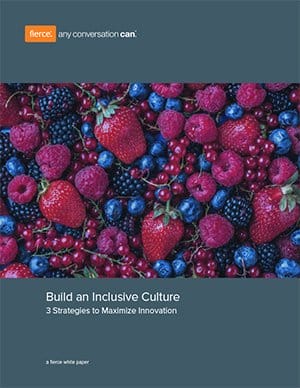In my experience with prospective and current Fierce clients, one of the greatest leadership training-related concerns that surfaces is sustainability. More specifically, how do we successfully implement reinforcement tools in our organization to maintain behavioral shifts after we’ve invested in a training program?
Sustainability seems to be an anomaly for many and it’s often mistaken as complicated. But, here’s something every leader needs to hear: newsflash! It most definitely doesn’t have to be.
The Most Common Sustainability Roadblocks
Changing human behavior is hard — this is why taking steps for sustainability is so important. My conversations with leaders have revealed a couple of common sustainability roadblocks that if not addressed, can prevent organizations from achieving maximum results from their training initiatives.
1. Ownership
There’s often confusion within organizations around ownership. Without overall accountability, a training investment won’t produce the hoped-for ROI. When there’s clarity around who “owns” what, these people can be properly set up for success, whether it’s the leadership and development team, managers, or both.
Also, take into consideration who has undergone the training — if a manager is responsible for reinforcement yet they haven’t participated in the program, how can you get them up to speed on what, and how, to reinforce?
To overcome this roadblock, organizations need to nail down who is accountable for sustainability and have a delegation plan. For example, who will implement the various action steps within the sustainability plan? Who will send out emails to participants, have coaching conversations, and continue one-on-one communication around training? Who will implement the relational sustainability tasks, and who will handle the administrative aspects?
2. Systems
Organizations often run into difficulty when it comes time to disperse information. Some questions to ask yourself are, what is the cadence that you reach out post-training? What is the best way to organize the information and what technology platform works best for what type of communication method?
If you want to successfully reinforce learning, you need to have a strategy to carry it out. The strategy used will depend on your individual resources, but common best practices include keeping messages short and easy to consume. We recommend weekly reach out for the first 3-6 months post-training. Having a weekly “Fierce Friday” email, for example, is a great way to keep short content top of mind for your learners.
People get a ton of emails, so if you have an internal social site or can create private groups for participants, this can be the most effective at getting them to engage with the content.
This can be a simple process — you just have to determine how the information will be dispersed, who will be accountable for it, and at what cadence it will be rolled out.
3. Culture
One of the main reasons training and development fails and behavior doesn’t sustain is that an organization’s dysfunction is so deep that it contradicts what is learned in the training. Often times this dysfunction starts at the top of an organization — and this is when conversations are even more critical.
Where learning can become important to partners in the business is not only identifying the dysfunction and elevating its impact on the business but also in creating a plan that is backed by action and system changes. To overcome this roadblock, we recommend you don’t talk about culture separate from the business — the reality is that having high turnover or low engagement impacts your company’s bottom line.
You’ll need to discover the root causes of dysfunction, like through a company-wide survey to determine where it’s costing your company money. Sharing this data is critical to helping your executive leaders see where behavior is leading to wasted money.
You should also paint the picture for your executive team on how they can support/change the culture and support/change the business.
When making recommendations around training and sustaining learning, involve key members in a conversation about what internal changes can be made that will tie the training into the company’s new “way of being.”
Some Easy Steps to Help Sustain Learning
Here are some tips for sustainability that will help make the process less cumbersome:
- Start from the beginning
Sustainability needs to be top of mind, even during the training program vetting process. Logistically, you will need to have plans in place to measure effectiveness, which requires pre and post-feedback from participants. When planning for sustainability, keep in mind that using a variety of reinforcement tools is going to be the most effective. In fact, according to Biz Dev, adding multiple reinforcements to training programs will increase retention from approximately 20 percent to more than 90 percent.
- If it’s simple, do it
Send reinforcement emails for bite-sized learning. Find simple ways to communicate, like posting some of the core concepts on a visible wall for daily reinforcement. Have one-on-one conversations, with clear accountability around who will lead them. Encourage the use of any sustainability tools provided through the training company (more on that in a minute), but keep in mind that additional actions need to be taken aside from the tools we offer.
- Break up your rollout strategy
Instead of knocking out the training all at once, consider rolling out the courses in phases. This will provide an opportunity for participants to practice and refine their behavior from the first phase and bring any lingering questions or challenges into the second phase where they will continue to build their skills.
- Incorporate training concepts into your systems and culture
Companies large and small need to integrate the most important aspects of the training into their processes and systems. Leaders need to be asking, “How can we weave these concepts into our culture?” This requires both action and a shift in mindset. This could include integrating the training language into your meetings and conversations, as well as adjusting how your organization functions day-to-day in order to encompass the concepts and philosophies of the training.
- Utilize sustainability tools made available by the training company
This seems like a no-brainer, but participants don’t always make full use of the resources they have available to them. For example, one of the tools Fierce employs is Mindmarker, and this simple platform helps with weekly reinforcement of learned concepts to help maintain behavioral shifts. When used regularly, it makes a big difference in sustainability — and “used regularly” are the key words here. Implement what’s available, and do it consistently.
Fortunately, reinforcing training doesn’t have to be a daunting monster to take on. Use the tips and approaches here and begin having the conversations around accountability, culture, and logistics to get clear before moving forward. With a sustainability plan in place, training can lead to big results for your organization.

ALIGN VALUES AND BEHAVIORS IN YOUR COMPANY
Start by building an inclusive workplace culture
Tags: #Leadership Training, #Sustainability



